
The BH&E returns as the NY&NE and builds Fishkill Landing ferry dock
The grand plan of the Boston Hartford and Erie Railroad had failed in 1870. Their plan had been to connect southern New England with a shipping port and ferry on the Hudson River at Dennings Point. Tracks were to be built from Connecticut through the southern part of Dutchess County to connect with the D&C/ND&C at Hopewell. (Hopewell was not yet a junction.) Grading of this line was well under way but track laying at Hopewell had just begun when the failure came. After the failure of the BH&E, the assets were reformed and emerged as the New York and New England Railroad, the NY&NE. By 1880 the ND&C records begin to show signs that the old BH&E plan of reaching the Hudson River was not really dead. The NY&NE RR planned to build a ferry facility at Fishkill Landing about a mile north of the old BH&E site at Dennings Point. The NY&NE decided to buy trackage rights on the existing ND&C RR between Hopewell and Wicopee. From Wicopee they planned to build a new section of tracks to connect with the ferry and the Hudson River RR at Fishkill Landing, now part of Beacon NY. In April 1881 there were more letters about installing switch connections and adding sidings on the east and west sides of the ND&C main track at Hopewell for the connections to the NY&NE RR. Construction at Hopewell began in earnest in May 1881. Much of the grading between Hopewell and Connecticut had been done by the BH&E before it failed, but little track had been laid down. Some part of the NY&NE tracks East of Hopewell had been built with access to the ND&C main line for the construction work eleven years earlier by the BH&E RR. This would have been the section of track on which George Brown’s midnight run trapped the BH&E engines in 1870. Now, after eleven years, the NY&NE resumed construction of the line.
On 11 May 1881 a NY&NE train from Connecticut arrived at Millerton and ran down the ND&C main line to Hopewell at 12 MPH. The engine was lettered NY&NE, and it pulled five flatcars and twenty dump cars. Three days later on May 14 there was a letter stating that NY&NE engines could use the ND&C main track south of Hopewell as far as the brook to get water. On 26 September 1881 there was a letter stating that the NY&NE expected to open for business in Hopewell on 15 October 1881. They did not quite make that schedule. On the 7th of October the NY&NE began running a daily gravel train from Hopewell to Wicopee on the ND&C main. This train seems to be hauling material for the NY&NE construction between Wicopee and Fishkill Landing. The NY&NE built a bridge over the HR RR to avoid traffic conflicts. After crossing the HR RR, the NY&NE tracks curved north on a trestle along the shore toward Fishkill Landing. The NY&NE ferry dock and yard were built on trestles and fill on top of shallow mud flats on the shore of the Hudson River. This route is still in use as part of the Metro North RR On October 8th 1881 a short note stated that the frog to connect the NY&NE main to the ND&C main at Hopewell was ready for installation. A temporary crossover connection to the ND&C main line was installed on 17 October 1881. With the completion of this connection Hopewell became Hopewell Junction. The new target date to begin operation was then 1 November 1881. They did not quite make that date either.
The first train from Boston used the temporary crossover connection at Hopewell Junction and arrived at Fishkill Landing on 21 October 1881. It was one passenger coach and a NY&NE office car. On board were 20 NY&NE officers and directors plus a reporter from the “Newburgh Journal”. After inspecting the work at Fishkill Landing and eating a hearty meal the reporter had his story and was dropped off at Matteawan as the train returned to Boston. On 5 December 1881 a letter went out to ND&C agents and conductors that the NY&NE would commence running trains 224 and 225 through to Fishkill Landing on Thursday, 8 December 1881. Additional letters to conductors and engineers explained that NY&NE trains had the same rights as ND&C trains on the tracks. For safety reasons all trains from both roads were to be entered in the register books at both Hopewell Junction and Wicopee Junction. Of course dispatchers and agents along the line were in communication via telegraph. That is unless the wires were down or the batteries were dead or somebody did not listen to the sounder. The main line connecting switch at Hopewell Junction was installed and traffic began moving on 8 December 1881. Four days later on 12 December the Fishkill Landing ferry began operations with a carload of New York State turkeys bound for Providence Rhode Island. The tracks Eastward from Fishkill Landing to Wicopee Junction ( in Beacon NY ) as well as the section from Hopewell Junction into Connecticut were complete enough for traffic to begin flowing. Christmas turkeys for the tables of Providence, RI passed over the ND&C tracks between Wicopee and Hopewell that cold December day.
The next few weeks saw a flurry of letters to smooth out operating difficulties. Imagine the situation: Here are two railroads trying to run scheduled trains, both passenger and freight, in both directions on one 11-mile section of single track main line between Hopewell Junction and Wicopee Junction.
In reading the letterbooks you can almost feel the frustration of the ND&C management in trying to control the situation. Here was a conservative local railroad trying to deal with an invasion of “cowboy” style train crews and still maintain safe operations. The NY&NE crews were moving freight as fast as possible for their company and dealing with a slow traffic bottleneck. There was a marked difference in style between the two roads. In 1882 neither side could know the future outcome, but the same conflicting relationship lasted for over twenty years. As far back as during the NY&NE construction there had been complaints that they were stealing workers away by offering more pay. By April 1882 ND&C track crews were demanding more money. The NYC & Hudson River RR track crews were already on strike, and ND&C crews were threatening to walk out. NYC track crews were being paid the rate of $1.20 per day, and the company had offered $1.35 per day, but they were holding out for $1.50 per day. ND&C crews were still at the $1.20 rate, and the foremen were paid $40 per month. ND&C superintendent Kimball wrote to President Schultze saying that the ND&C had no alternative but to raise worker’s pay. He suggested $1.35 per day for the laborers and $45 per month for the foremen. He also stated that if the other railroads in the area are forced to the $1.50 rate, the ND&C would have to match it or lose the crews. On 22 April 1882 ND&C track crew pay was increased to $1.35 per day, and foremen’s salary was increased to $45 per month. Of all the freight carried by railroads there was probably more coal than any other item. Homes, businesses, industry, steamboats and railroads were all heated or powered by coal. Every small town had at least one coal dealer and sometimes several. In many situations dealers in an area were supplied by different railroads which sometimes involved intense competition or some sort of “gentleman’s agreement” to maintain prices. Since railroads did not always trust each other or honor the “agreements”, there was considerable friction and sometimes open hostility in the coal business. This was particularly true after the opening of the Poughkeepsie Railroad Bridge in 1888, which opened a direct rail route to the coal fields without slow and expensive ferry service across the Hudson River.
Sparks from engine smokestacks were always a problem, but poor maintenance of the stacks and screens made things worse. In the summer of 1882 there were many grass fires along the line. Kimball wrote to the NY&NE Master Mechanic in Hartford saying “Fix your engines. Number 42 started 5 fires in Matteawan today.”. Two days later on August 7 he wrote to G. M. Felton, the NY&NE General Manager in Boston.
“Your engines started fires in about twenty places yesterday between Wicopee and Hopewell and in two places destroyed a long piece of RR fencing besides burning over about sixty acres of farm land and considerable farm fence.”
During 20 years of struggling, the track and tonnage rental paid by the NY&NE often was the difference between red and black ink in the ND&C ledgers. In the first three months of 1883 the rental numbers were: January $2437.05, February $2418.22 and March $2968.89. The NY&NE probably considered it highway robbery. This was a significant portion of the ND&C income when you consider that their total profit for the year 1882 was only $367.74. By 1887 the NY&NE was pressuring the ND&C for a new contract to reduce the track rental payments. Meanwhile, the ND&C continued sending letters to the NY&NE complaining about their locomotives starting fires and about the overdue payments for damage to ND&C equipment. By mid 1882 the ND&C was becoming dependent on the NY&NE for local freight service back and forth across the river to Newburgh. The two roads agreed on rates and the ND&C closed down their car float operations at Dutchess Junction. ND&C local freight business was actually carried across the Hudson River by the NY&NE at their Fishkill Landing facilities. Three years later, in 1885, the NY&NE began undercutting the ND&C milk business by shipping milk from Hopewell Junction to New York City. The ND&C was being squeezed by the much larger NY&NE operation. Even so they continued to survive on revenues from passenger service, milk shipments, ore shipments out of Sylvan Lake, plus coal and freight along the line between Hopewell and Millerton and, of course, the NY&NE trackage rental payments.
With the opening of the Poughkeepsie Railroad Bridge in December 1888, the NY&NE ferry at Fishkill Landing began to feel the pinch of competition from coal trains rolling across the river into Dutchess County. Ferry service would sometimes come to a halt when the Hudson River ice became too thick in the winter. The Bridge did not have this problem. The Bridge route also was faster without the handling required to get train cars on and off a ferry boat. The NY&NE faced an even greater challenge in the form of J. P. Morgan and the New Haven RR. The two roads were in direct competition in the New England area, and the New Haven began cutting off access to NY&NE business. NY&NE revenues dropped, and J. P. Morgan began acquiring NY&NE stock at low prices. By 1895 he had control of the NY&NE and along with it the Fishkill Landing ferry terminal. The ND&C books began to refer to the NY&NE as the New England RR.
The influence of New Haven RR control began to show early in 1896. The NE RR was making a concerted effort to capture the milk hauling business in Dutchess County. The name “New England RR” did not last long. Within three years, in July of 1898, the name was again changed. The ND&C line from Hopewell Junction to Wicopee Junction was then traveled by trains of the New York, New Haven and Hartford RR, Highland Division. Fishkill Landing operated as part of the New Haven RR. A few years later, in June 1904 the New Haven RR withdrew all passenger service on the line but continued to handle freight. Later that same summer, the train car ferry was discontinued leaving the connection with the NYC Hudson Line. After years of a stormy relationship the NY&NE was no more, and the ND&C survived. But then the ND&C had the giant New Haven RR at their door with J. P. Morgan running the show. In 1905 the New Haven RR purchased the ailing ND&C RR and turned it over to the CNE Rwy to operate. The CNE promptly began getting rid of some ND&C facilities. The first to go was Dutchess Junction. By 1907 the ND&C shops had been sold for salvage. Passenger service to Dutchess Junction stopped in 1916 and CNE trains stopped at Fishkill Landing instead. In 1927 the CNE Rwy was absorbed into the New Haven and Fishkill Landing became a New Haven RR facility.
**********
The first phase of the NYC rebuilding at Fishkill Landing starting in 1913.
**********
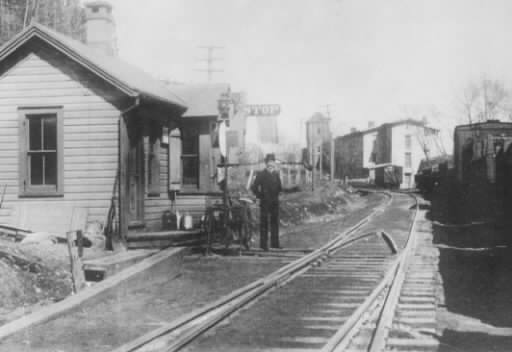
Wicopee Junction in Matteawan NY is now part of the City of Beacon. This was the connection between the original D&C/ND&C and the NY&NE.
In the background you can see the New York Rubber Company building along Tioronda Avenue which is behind the watchman’s shack at left.
**********
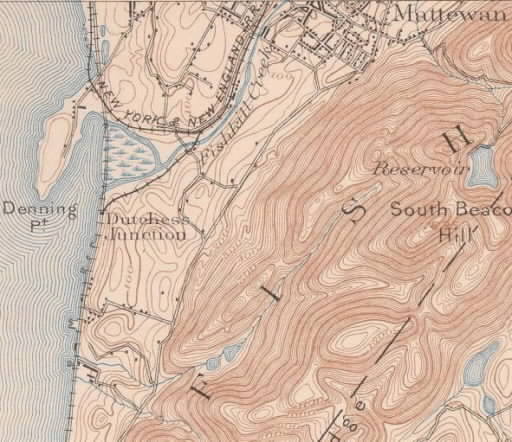
The ND&C tracks enter the map at top center along the streambed of the Fishkill Creek. Even though the line is labeled New York and New England RR, the tracks in Matteawan actually belonged to the ND&C RR. The ND&C line crossed the Tioronda Bridge high over Fishkill Creek and ended at the bottom of the hill at Dutchess Junction. In 1881 the NY&NE built the tracks going to the upper left on a bridge over the NYC Hudson line and north along the shore of the Hudson River. These tracks were built on trestles and fill to reach the new ferry facility at Fishkill Landing which is just off the top of this map. The point where the two lines join along the creek was Wicopee Junction. The tracks built by the NY&NE and the ND&C line are still in service and owned by the MTA Metro North RR. The CNE discontinued service to Dutchess Junction in 1916 and sold the Tioronda Bridge for scrap. The abutments of the bridge are now Madam Brett Mill Park in the City of Beacon.
**********
![]()
Beacon NY about 1970.
On this later map the tracks to Dutchess Junction are gone. The areas that were Matteawan and Fishkill Landing are now part of Beacon. The ferry facility built on fill at upper left still has tracks but no ferry service. At lower left you can see a curved row of pilings in the shallow water near Dennings Point. These were built by the BH&E RR with the intention of adding tracks to a deep water port on Dennings Point. They went bankrupt in 1870 before the tracks were added to the pilings. Even today boaters can find these pilings at low tide.
**********
![]()
This is an enlarged section of the previous map showing the dock area of what was Fishkill Landing. The NYC main line runs north and south through the center. NY&NE and later CNE and NH tracks run on trestles and fill between the shore and the NYC main line at lower left. Just below the center there is a road bridge over the NYC tracks. This bridge shows in many of the following photos and was rebuilt during the reconstruction in 1913 to 1915. North of the road bridge you can see a set of yard tracks to the right of the NYC main. During rebuilding of this area those tracks served as a bypass for the NYC main line. The label “Penn Central RR” dates this map to about 1970.
**********
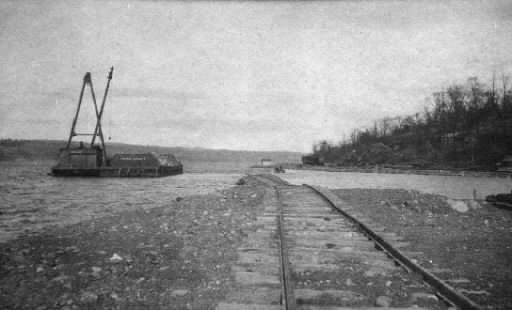
Filling the shore line to build Fishkill Landing tracks.
Beacon Historical Society collection
In those days even construction equipment was named. The barge in this photo is named Great Light.
**********
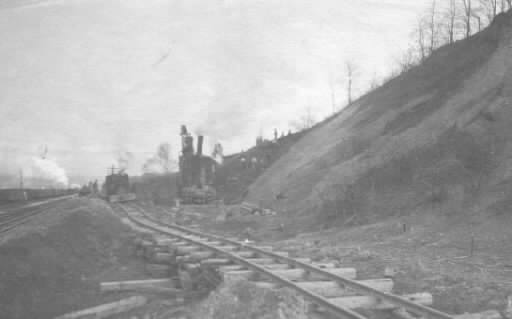
Digging to make more room for Fishkill Landing tracks.
Beacon Historical Society collection
**********
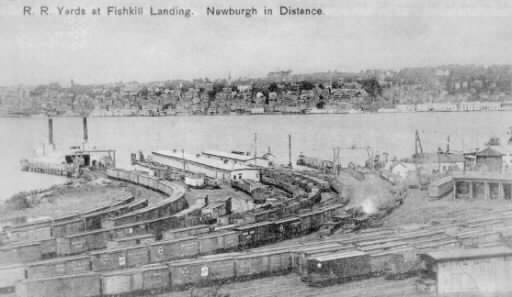
Postcard view of the NY&NE ferry facility at Fishkill Landing.
This entire yard area was built on fill. Note the turntable, engine house and water tower at right. Two switch engines stand ready for the next ferry at lower right under the puff of steam. At left you can see the double smokestacks of the ferry William T. Hart at the dock. The City of Newburgh NY is directly across the river.
**********
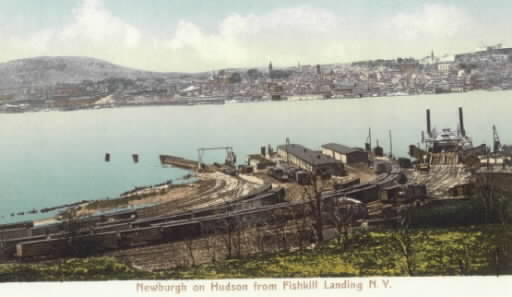
Another view of the NY&NE ferry at Fishkill Landing. This time the ferry William T. Hart is at the other dock at right. You can see the tracks leading out onto the deck of the ferry.
**********
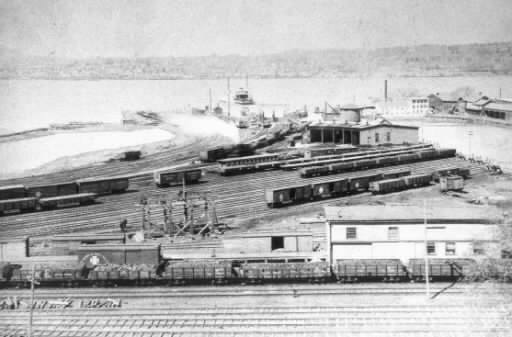
The NY&NE ferry facility at Fishkill Landing.
Beacon Historical Society collection
In this photo it looks like the William T. Hart has just pulled away from the dock on the way to the Erie RR dock in Newburgh. Note the cross symbol on the freight car in the lower left. That was the symbol for the NY&NE RR. The NYC main Line passes by at the bottom of the picture. At far right you can see part of the Fishkill Landing to Newburgh passenger ferry facilities. The street by those buildings is an extension of Ferry Avenue built on fill and trestles. In later photos the passenger ferry dock has been moved to a new location on the shore off the right edge of the picture.
After the big RR bridge in Poughkeepsie opened in January 1889, the Fishkill Landing ferry began to feel the competition. In 1904 the William T. Hart RR car ferry service was discontinued by the New Haven RR. Freight and passenger trains were routed across the Poughkeepsie bridge which became part of the Maybrook Line.
**********
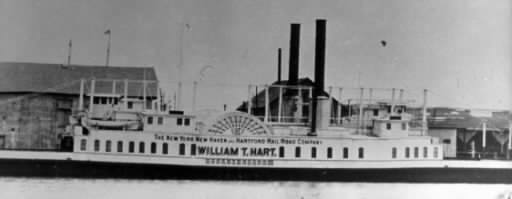
RR car ferry William T. Hart.
Beacon Historical Society collection
This ferry was named for a president of the NY&NE railroad. When the New Haven RR took over they retained the name. At the time this ferry went into service in 1881 she was the second largest ferry boat in the world, being over 300 feet long. The Hart had two independent steam engines, one for each side paddle wheel. By reversing one engine the Hart could turn around in her own length. The Hart required a crew of 24 men for normal operation and could carry up to 27 freight cars at a time. The Hart was originally intended for service in New York harbor but they soon discovered that the stacks were too tall to fit under some of the bridges.
**********
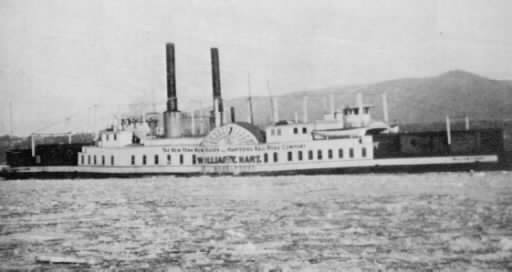
William T. Hart RR car ferry
Beacon Historical Society collection
This photo shows the Hart in the middle of the Hudson River with a full load of freight cars.
**********
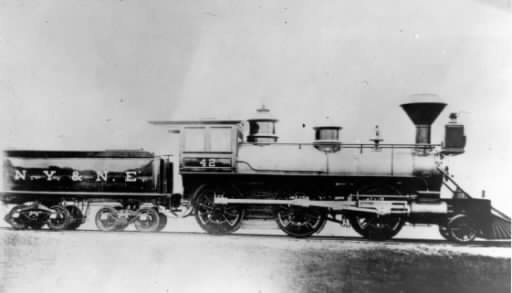
NY&NE #42
Beacon Historical Society collection
This is the NY&NE engine that ND&C superintendent Kimball complained about when it was throwing sparks from the stack and setting grass fires along the ND&C tracks. This engine was built by the Rhode Island Locomotive Works in 1879. After the New Haven RR took over she became #942 and later #711.
**********

Newburgh waterfront in 1891.
This 1891 map of Newburgh shows that there were at least two ferry docks. In the upper left is the West Shore ferry dock. Just right of center is the Erie RR ferry dock.
**********
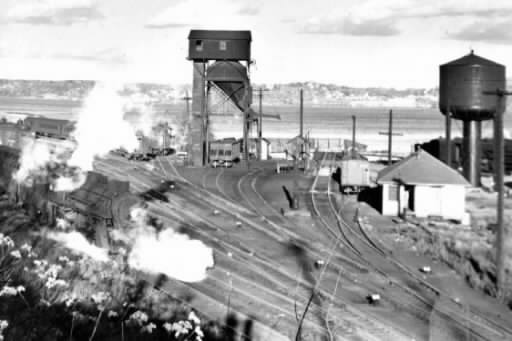
Newburgh RR car ferry dock.
Beacon Historical Society collection
This photo is the ferry dock on the Newburgh side of the river with the City of Beacon in the background.
**********
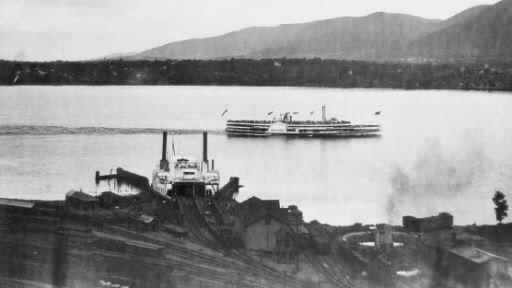
RR car ferry at Newburgh
Beacon Historical Society collection
The City of Beacon is in the background at the foot of Mt. Beacon. The mountain got it’s name during the revolutionary war. Signal fires on the top of the mountain were used to warn of the British ships coming up the river. In later years there was an inclined cable railway to the top where there was a dance hall and casino.
**********
The second phase of the NYC rebuilding in 1914 and 1915
**********
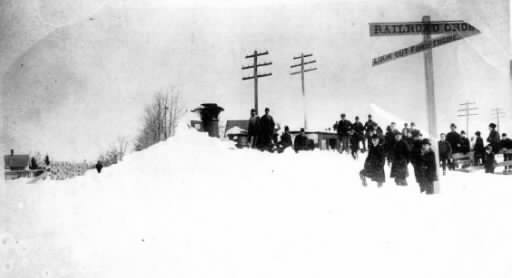
Engine #100 in the snow
Beacon Historical Society collection
This photo was undated but I suspect that it was taken during the big blizzard of March 1888.
**********
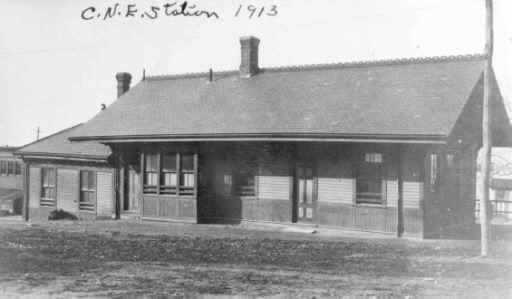
CNE station at Fishkill Landing in 1913.
Beacon Historical Society collection
This was the earlier CNE station at Fishkill Landing. It was replaced by a new combined CNE/NYC station during the waterfront reconstruction between 1913 and 1915. It was located at the west end of the road bridge over the NYC main line. The CNE tracks along the shore were in back of the building. You can see a bit of a passenger coach at the left edge of the picture. Before the reconstruction the CNE tracks ended at this point. When the new station was opened the CNE tracks were extended north to the new station near the new ferry building.
**********
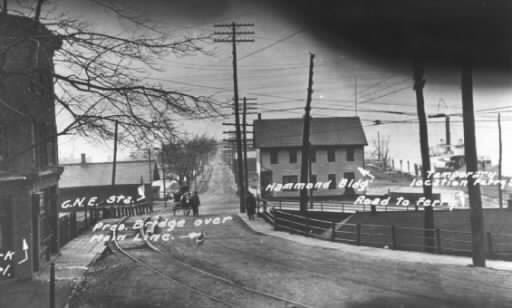
Early road bridge over the NYC main line.
Beacon Historical Society collection
This view is looking west toward the Hudson River before the reconstruction started. The road to the older ferry dock runs off into the distance. The Hammond building was a paint and insecticide manufacturing plant. At the right edge of this photo is a temporary ferry dock used during the reconstruction work. A new ferry dock and building would be built just off the right edge of this scene. Note the trolley tracks running across the bridge.
**********
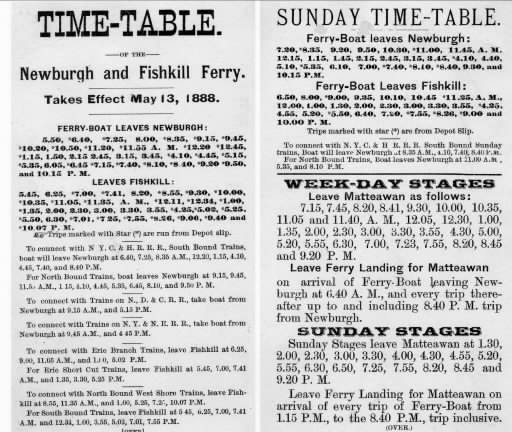
**********
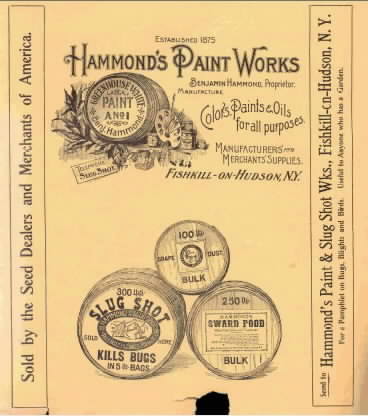
Beacon Historical Society collection
The Hammond manufacturing building was located at the west end of the bridge over the NYC.
**********
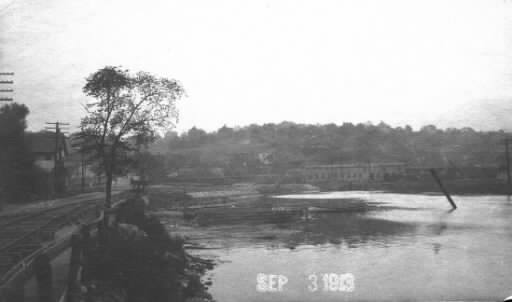
Fishkill Landing ferry road in 1913.
Beacon Historical Society collection
This photo was taken before most of the reconstruction work. It shows the road built on fill out to the old passenger ferry dock. The bridge over the NYC main line is left of center. The early CNE station had already been removed from the corner by the bridge.
**********
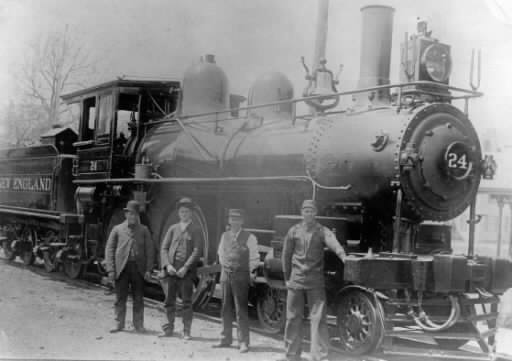
New England RR #24
Beacon Historical Society collection
In 1893 the NY&NE RR became part of the New Haven family and was renamed as the New England RR. By 1898 the line was formally part of the New Haven RR.
**********
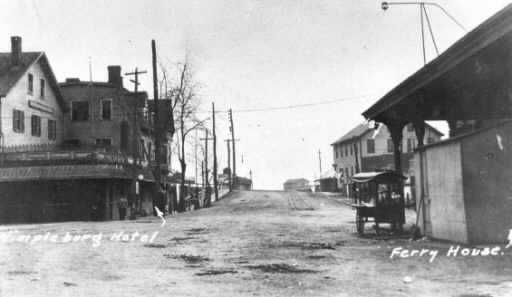
Fishkill Landing before the reconstruction
Beacon Historical Society collection
This is the street at the west end of the road bridge over the NYC. The Hammond building is in the right distance. Note the trolley tracks which curved to the left and over the bridge. At far left is the Wimpleburg Hotel which was adjacent to the NYC main line. What a nice quiet spot for a hotel.
**********
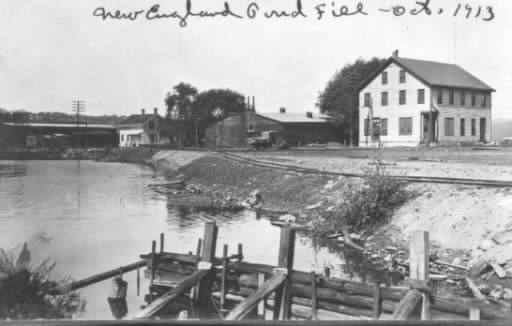
Beginning of reconstruction at Fishkill Landing
Beacon Historical Society collection
This would be in late 1913 and the old CNE station is gone and fill is extending the land area of Fishkill Landing.
**********
New York Central in the Fishkill Landing Area.
**********
A New Hudson Bridge, Revived Beacon Line, HYPERLOOP and More
The Maybrook Line was a line of the New York, New Haven and Hartford Railroad which connected with its Waterbury Branch in Derby, Connecticut, and its Maybrook Yard in Maybrook, New York, where it interchanged with other carriers.
If one looks at the most popular Pages on our WebSite, over half directly reference the Maybrook Line. Lot’s of folks have an interest in it. The “Maybrook Line” was important to New England before the advent of Penn Central and before the Poughkeepsie Bridge burned. This piece of the railroad carried freight from Maybrook Yard, across the Poughkeepsie Bridge to Hopewell Junction where it joined a line from Beacon. The railroad then went to Brewster, then Danbury, and finally to Cedar Hill Yard in New Haven.
WHY and How To Fix The “MAYBROOK LINE”?
Container port/intermodal facility/rail bridge
The construction of a railroad bridge between New Hamburg and Marlboro is likely the least expensive place to build a Hudson River crossing between Manhattan and Albany. The stone for ramps, sand and gravel for concrete and a steel beam assembly and storage area would be right on sight. All materials and equipment could be transported by barge or boat. The bridge itself would have only four or five piers (the most costly part to build) since the Hudson River is about the same width as it is in Poughkeepsie.
The Hudson River component connects Dutchess, Ulster and Orange counties to the world economy (finished goods, spare parts, components parts, raw materials, food stuffs) and the railroad and interstate road components connect these NY counties to the rest of North America (US, Mexico, Canada).
With the container port/intermodal facility/rail bridge, the flow in and out of raw materials, spare parts, partially finished goods, foodstuffs and components will allow for new industries and businesses to locate near this facility and add to the tax base of these three NY counties: Dutchess, Ulster and Orange counties.
Although the Dutchess County Airport is a tiny regional airport with a 5,000 foot runway, it has some big potential. The airport land extends a mile Northeast of the present runway end at New Hackensack Road and borders on the former New Haven Maybrook Line/Dutchess Rail Trail. As the NY Air National Guard gets crowded out by international air traffic at Stewart International Airport their operation could be moved over to Dutchess Airport without disrupting the lives of the guard members and their families through forced relocation.
Beacon itself is exploding with “developer” activity, and it needs a trolley or light rail for the city only to transform back into a pedestrian oriented city.
Other activities include: Solidization of rail links in Connecticut to handle increased traffic; a possible HYPERLINK for improved service along the Beacon Line and in/out of New York City
Now you are going to ask. What does the New York City Metropolitan Transportation Authority have to do with the “BEACON LINE”? IT OWNS IT! Must realize that NYCMTA is a “regional” organization. With all that went on with Penn-Central and CONRAIL somebody had to own it!
************
Go To World’s Greatest WebSite
>>> New York Subways
>>>Commuters, Car Culture and The Jenny Plan
>>>Long Island Railroad
>>>Chicago, South Shore & South Bend Railroad
>>>POTUS – Trains for the President
>>>Milk Trains
>>>The Fabled Rutland Milk
>>>The Muhammad Ali Hyperlink
About Our Great WebSite
>>>>>>About Troop Trains
>>>Metro North Railroad
>>>A Collection of Short Stories about Railroads – Book One
>>>>>>Buffalo Creek Railroad
>>>A Collection of Short Stories about Railroads – Book Two
>>>>>>Troy & Greenbush Railroad
>>>DL&W Railroad, Erie Lackawanna and Lackawanna Cutoff
>>>Circus Trains
>>>>>>Disposition Of Circus Trains
>>>Robert Moses – Against Mass Transit
>>>Troop Trains
>>>>>>Troop Train Movie
>>>Railroader Biographies
>>>>>>George H. Daniels
>>>>>>Plimmon H Dudley
>>>>>>Leonore F. Loree
>>>John W. Barriger: Rail Historian and Railfan
Contact and Great Blogs
Other Interesting WebSites
>>>Ontario & Western Railroad
>>>Connecticut To Philadelphia
>>>Central New York Railroad
>>>Chicago, Rail Capital
>>>The Ride To Choate
>>>Union Pacific Railroad-established by Abraham Lincoln to span the continent
>>>The Warwick Valley and Other Railroads West of the Hudson
>>>Short Line Railroads
>>>>>>Little Falls & Dolgeville
>>>>>>Gary Railway
>>>>>>The Owasco River Railway
>>>>>>Dexter and Northern Railroad Company
>>>Philadelphia, Pennsylvania
>>>Washington, the Nation`s Capital
>>>Royal Tour 1939
>>>The Monon Railroad
>>>Big 4 Bridge: Jeffersonville to Louisville
>>>Chicago & Western Indiana Railroad
>>>The Southern New York Railway
>>>Electric Railroads
>>>Lines West
>>>High Speed Rail
>>>Northeast Corridor
>>>New York State
Some Fascinating WebPages
>>>New York State Railroads, and NY Central Railroad
>>>Delaware & Hudson Railway
>>>Lehigh Valley Railroad
>>>Head End Equipment
>>>Boston & Maine Railroad
>>>The Four Railroads of Utica
>>>>>>Gulf Curve, April 1940 New York Central Accident
>>>>>>New York Mills Branch On The West Shore
>>>Railroad Mergers
>>>Railroad Bridges and Tunnels
>>>My last ride on the JFK Express subway in April 1990
>>>Chicago Bypass
>>>Van Sweringen Brothers, Nickel Plate and Other Ohio Railroads
>>>New York City Transit Planning
>>>Tahawus: Railroad to a Mine
>>>Chicago Rail Fair
>>>Joint Winter Olympics for Montreal and Lake Placid
>>>Abandoned Railroads
>>>>>>Putnam Division Abandonments
>>>Amtrak’s Secret Business
>>>Alphabet Routes
>>>EMD Model 40
>>>Budd RDC
>>>Benton Harbor – Once A Rail Center
>>>Snow and Railroads
Central New England Railway
>>>>>>The Central New England In Connecticut
>>>>>>New York and New England Railroad
>>>>>>1937 Fan Trip
>>>Central New England Railway In New York State
>>>The Railroads Of Pine Plains
>>>CNE in Hopewell Junction
>>>The Maybrook Line Across Dutchess County
>>>The Great Bridge At Poughkeepsie
>>>Poughkeepsie Bridge After The Fire
>>>The Rhinebeck & Connecticut Railroad
>>>Central New England Railway Connecticut Connection
>>>Maybrook Yard
>>>>>>Maybrook Yard 1940’s (Maybrook Journal)
>>>Newburgh, Dutchess and Connecticut Railroad (ND&C)
>>>>>>CNE/NDC Dutchess Junction and Matteawan
>>>>>>CNE/NDC Glenham to Hopewell Junction
>>>>>>CNE/NDC Hopewell Junction to Millbrook
>>>>>>CNE/NDC Bangall and Pine Plains
>>>>>>CNE/ND&C between Pine Plains and Millerton
>>>Fishkill Landing
>>>>>>The First Phase Of The NYC Rebuilding At Fishkill Landing
>>>>>>The Second Phase Of The NYC Rebuilding At Fishkill Landing
>>>>>>The Final Phase Of The NYC Rebuilding At Fishkill Landing
>>>Poughkeepsie & Eastern in the Poughkeepsie Area
>>>Poughkeepsie & Eastern North from Poughkeepsie
>>>One of the railroads that made up the CNE Railway was the Poughkeepsie & Connecticut
Environment
>>>WEATHERTOPIA
Supply Chain Management
>>>Supply Chain Synchronization
Vacation French Riviera
>>>Castillon
>>>Menton
New Haven Railroad
>>>George Alpert, Last New Haven President
>>>Essex Steam Train
>>>Newport and Rhode Island Railroads
>>>Railroads To Cape Cod
>>>Cedar Hill Railroad Yard In New Haven
>>>Housatonic Railroad
>>>Manufacturers Street Railway in New Haven
>>>Train Stations Of Connecticut
>>>Boston and New England Railroads
>>>New Haven RR Signal Stations
>>>Connecticut Railfan
>>>Connecticut Freight Railroads
>>>Shoreline Bridges Of The New Haven Railroad
>>>Old Railroads Of Connecticut
>>>The Trolley In Connecticut
>>>The Shepaug Valley Railroad
You must be logged in to post a comment.